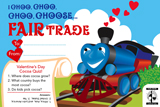by Ariel Corazon Clay
Monday, Feb. 05, 2007 at 12:16 PM
fairtrade@globalexchange.org
Children and their teachers across the country are coming together this Valentine’s Day to stop child labor, child trafficking, and child slavery in the cocoa fields.

valentine_small.jpg, image/jpeg, 160x107
Children are sending valentines to World’s Finest Chocolate asking the company, which is the country’s leading manufacturer of fundraising chocolate, to switch at least 5% of its cocoa to Fair Trade Certified. The front panel of the union-made/recycled/vegetable ink valentines is a traditional, retro design that children can distribute to their classmates and teachers can give to their students. The back panel is a detachable post card that the recipient signs and sends to World’s Finest Chocolate. Elementary school classrooms are learning about Fair Trade chocolate from the Valentine’s Day Fair Trade Cocoa Curricula produced by human rights organization Global Exchange. Some teachers are also using Valentine’s Day Action Kits, which include Fair Trade Chocolate minis for their students.
There are two ways that practices on conventional cocoa farms create a barrier to education. First, children in cocoa-growing regions cannot attend school because their parents, many of whom are cocoa farmers, are not paid a living wage and cannot afford school fees. Second, many cocoa farms use cheap child labor, or even child slaves, to keep production costs low.
In West Africa, more than 60% of the children working on cocoa farms are under the age of 14. Children on cocoa farms are engaged in dangerous activities such as spraying pesticides, harvesting seedpods and clearing forests with machetes.
The Ivory Coast, where over 40% of the world’s cocoa is produced , is one of the countries where serious violations of children’s rights in the cocoa industry have been documented. In the Ivory Coast, 87% of the permanent labor used in cocoa farming comes from the family and one third of cocoa farmers’ children have never attended school. A study in 2002 by the ILO estimated that 12,000 trafficked children worked in the cocoa fields of the Ivory Coast as slaves.
This practice caught the attention of the media and the United States government in 2001. In response, the US chocolate industry agreed to voluntarily take steps to end child slavery on cocoa farms by July of 2005, via the Harkin-Engel Protocol. Children’s rights advocates argue that the chocolate industry is putting profits ahead of basic human rights protections and children’s rights because it did not fully implement even these meager voluntary provisions and the Protocol does not address low cocoa prices, which is the root cause of child labor and slavery in the industry.
This is where World’s Finest Chocolate comes in. Most of us recall World’s Finest Chocolate; they are the bars that we schlepped around as kids for those school fundraisers or purchased from our local church groups to help fund after-school activities. But little did we know that the same chocolate bar can stand in the way of a child’s education in a cocoa-producing region.
World’s Finest Chocolate is a pioneer of "product fundraising" with estimated annual sales of over $110 million. World's Finest ranks among the eight largest chocolate companies in the U.S. It is the leading manufacturer of chocolate for fundraising. Over 40,000 schools and youth groups across the U.S. participate in World’s Finest Chocolate fundraisers.
The company has built its chocolate industry leadership status on the foundation of a corporate image closely linked with supporting educational opportunities for children. Now in its third generation, the family-owned firm has a fifty-year legacy of supporting education, community development and other charitable causes with its chocolate products and fundraising infrastructure. However, while nearly fifty cents of every one-dollar bar of World's Finest has gone to support local schools, youth groups and other charitable organizations, scarcely pennies reach impoverished cocoa farmers and their families.
Global Exchange is inviting kids and adults to have a heartfelt Valentine’s Day by visiting its website, www.globalexchange.org/cocoa, where visitors can order free valentines, download the curriculum, or send a fax to World’s Finest Chocolate.
www.globalexchange.org/cocoa

